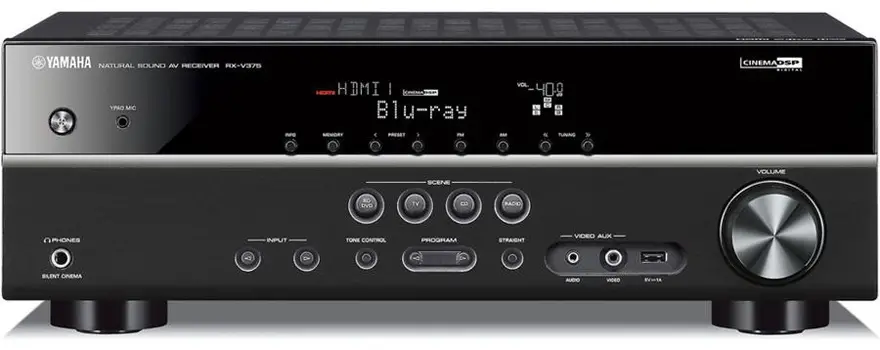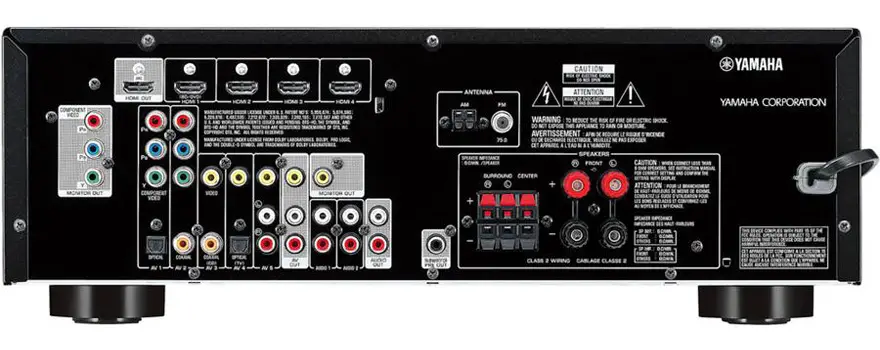Yamaha may not exactly be a brand that consumers think about when wanting to spice up their home entertainment systems but the Japanese giant continues to prove itself as a top contender in the home theater receiver space. The company also aims to add some more value to consumers that don’t exactly have $500 to spare on a home theater receiver. Yamaha already had that market covered with the $299 RX-V373 AV receiver and it now shifts its resources to the newer Yamaha RX-V375 which maintains the $299 price tag but it boasts higher sound quality thanks to its discrete amp configuration.
Design
Yamaha did nothing to change the design of the RX-V375. It weighs a little bit lighter than the RX-V373 but it still has the same familiar layout. It should blend in with other black home theater components and the overall appearance doesn’t exactly look cheap. In fact, the button layout is pretty friendly with the most prominent buttons being the four SCENE buttons that serve as both a source and DSP mode selector. Although each SCENE button has a label, you may customize the buttons too.
It is always good to have a USB port on the front of an AV receiver especially if the receiver won’t have any networking capabilities. The USB port found on the front of the Yamaha RX-V375 allows you to plug in any Apple mobile device using the usual USB cable. A digital signal is established all the way through so you won’t experience any signal losses when playing back music. This connection also keeps these Apple devices charged. When playing back music, the song titles show up on the front panel display. Other audio players have to rely on the mini-jack input on the front.
You can’t really expect a lot from a $300 home theater receiver so the back side of the RX-V375 shouldn’t look very surprising. You have four HDMI inputs to work with along with a single HDMI output. Like its predecessor, you have to rely on these HDMI ports if you want to take advantage of the latest technologies like 3D support and 4K pass-through. Future generation TVs will sport bigger screens and higher resolutions and the Yamaha RX-V375 will be ready to handle those pixels. There is still room for older home theater equipment that rely on composite and component connections.
Below is the back panel layout. Click on image to enlarge for a clearer view.
Features
The main new feature of the RX-V375 happens to be the most significant upgrade over the RX-V373. Now employing a discrete amp configuration, the sound quality of the Yamaha RX-V375 is much better in terms of clarity and it also features a low jitter PLL circuit for improved audio performance. Even though the RX-V375 features the same 100 watts per channel specs for 5.1-speaker configurations, you should notice some nice improvements to the audio quality.
But to really notice the audio improvements, you have to properly optimize the speakers hooked up the receiver. Yamaha continues to rely on their YPAO sound optimization technology to get the job done. Like other speaker calibration solutions, you can calibrate your setup very quickly by just positioning the included microphone to the center of the listening area and then let the system work its magic in analyzing room acoustics and making the appropriate audio parameter adjustments.
A number of Yamaha’s other audio boosting technologies have made it down to the Yamaha RX-V375. This includes the CINEMA DSP technology which represents Yamaha’s support for various HD audio codecs like Dolby TrueHD and DTS-HD Master audio. Bass quality is also very good for an entry-level receiver because of the Subwoofer Trim Control. This function adds stability to the front stage by giving the low subwoofer frequencies its own channel to eliminate overlapping.
Many audio enthusiasts prefer playing music in uncompressed formats like FLAC because they boast the best audio quality. But there are a few problems with high quality music formats. First, Apple devices don’t support FLAC and second, the file sizes of these file types are very large. MP3 files are smaller but the audio quality is sacrificed. This isn’t the case with the RX-V375 because it features the Compressed Music Enhancer which attempts to rescue the lost audio data through digital signal processing techniques.
The disadvantage of owning a basic TV is obviously the lack of technologies present. For example, you might experience those instances where you want to turn up the volume for this movie channel and then switch to another channel containing a commercial where the volume level is far more powerful. Higher-end TVs come with a volume normalizing function to remedy the issue. But you don’t have to upgrade your TV to enjoy this convenience because the Yamaha RX-V375 provides a feature called Adaptive DRC or Dynamic Range Control. Not only does this function automatically tone down those annoyingly loud TV commercials but it also balances all aspects of the sound from the sound effects to the vocals. You will find yourself adjusting the volume less frequently even if you switch to other sources. Because this technology works by automatically adjusting the dynamic range based on the volume level, you will find this feature to be great for watching content late at night where you don’t want to wake up other people.
Getting an entry-level receiver is also good if you don’t want to drive up your electric bill. But the RX-V375 wants to emphasize lower power consumption a little bit more with its ECO mode feature. All you have to do is turn it on from the GUI menu and you instantly enjoy 20% power savings. It is also possible to tell the Yamaha RX-V375 to automatically shut down after 2 to 12 hours to save even more electricity while the receiver is idle.
Bottom Line
With the RX-V375 already being sold in retail and online stores, it could be possible to spot the older RX-V373 at a cheaper price. But going for the Yamaha RX-V375 is more worthwhile because it has the same discrete amp configuration that higher-end receivers have. This added feature is a must if audio quality really matters but you can’t afford a pricier receiver.


